Organic Pest Control in Fraser Fir Christmas Trees
go.ncsu.edu/readext?297902
en Español / em Português
El inglés es el idioma de control de esta página. En la medida en que haya algún conflicto entre la traducción al inglés y la traducción, el inglés prevalece.
Al hacer clic en el enlace de traducción se activa un servicio de traducción gratuito para convertir la página al español. Al igual que con cualquier traducción por Internet, la conversión no es sensible al contexto y puede que no traduzca el texto en su significado original. NC State Extension no garantiza la exactitud del texto traducido. Por favor, tenga en cuenta que algunas aplicaciones y/o servicios pueden no funcionar como se espera cuando se traducen.
Português
Inglês é o idioma de controle desta página. Na medida que haja algum conflito entre o texto original em Inglês e a tradução, o Inglês prevalece.
Ao clicar no link de tradução, um serviço gratuito de tradução será ativado para converter a página para o Português. Como em qualquer tradução pela internet, a conversão não é sensivel ao contexto e pode não ocorrer a tradução para o significado orginal. O serviço de Extensão da Carolina do Norte (NC State Extension) não garante a exatidão do texto traduzido. Por favor, observe que algumas funções ou serviços podem não funcionar como esperado após a tradução.
English
English is the controlling language of this page. To the extent there is any conflict between the English text and the translation, English controls.
Clicking on the translation link activates a free translation service to convert the page to Spanish. As with any Internet translation, the conversion is not context-sensitive and may not translate the text to its original meaning. NC State Extension does not guarantee the accuracy of the translated text. Please note that some applications and/or services may not function as expected when translated.
Collapse ▲The organic production of Fraser fir Christmas trees is not easy. Fraser fir is a slow-growing tree that only produces one flush of growth each year. Grasses and weeds can choke out and kill young Fraser fir seedlings. It is harder to get soil nutrition for trees through organic fertilizers. Pesticides such as horticultural oil are harder to apply and more costly. Therefore, when it comes to pest control, it is important to start with a good site, scout regularly, and control problems before they become widespread.
Cultural Controls
Since pest control will not be as easy with organic pesticides, it is important follow good cultural practices that promote tree growth and reduce problems with pests. These include the following:
Site Selection and Spruce Spider Mite
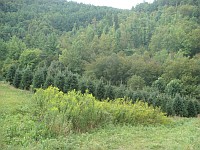 Spider mites (SSM) are not easy to control organically. Therefore, it’s important to grow trees in a habitat that favors predatory mites and not spider mites. Predatory mites prefer cooler and more humid conditions than the SSM. Frasers grown at elevations lower than 3,000 almost always have problems with SSM. So do trees grown on a south or south-west exposure. A Christmas tree field surrounded by woods almost never has a problem with spider mites. Avoid windy ridges. Dust from gravel roads also create SSM problems. The dust that settles on the needles will kill the predatory mites by damaging their exoskeleton as they run in search of prey, causing them to dry out and die. The more sedentary SSM are not affected. Providing a habitat that does not favor mites will go a long way in reducing the need to treat for them.
Spider mites (SSM) are not easy to control organically. Therefore, it’s important to grow trees in a habitat that favors predatory mites and not spider mites. Predatory mites prefer cooler and more humid conditions than the SSM. Frasers grown at elevations lower than 3,000 almost always have problems with SSM. So do trees grown on a south or south-west exposure. A Christmas tree field surrounded by woods almost never has a problem with spider mites. Avoid windy ridges. Dust from gravel roads also create SSM problems. The dust that settles on the needles will kill the predatory mites by damaging their exoskeleton as they run in search of prey, causing them to dry out and die. The more sedentary SSM are not affected. Providing a habitat that does not favor mites will go a long way in reducing the need to treat for them.
Avoid Close Proximity to balsam woolly adelgid
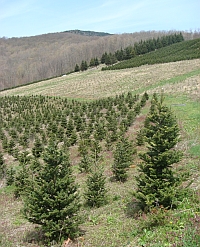 The same thing is true for the balsam woolly adelgid (BWA). Though it can be controlled organically, treatments will need to be made every year. To reduce pressure from BWA, avoid placing an organic Christmas tree field near natural stands of Fraser fir, near true firs that are growing in yards or in Christmas tree fields that are abandoned or not properly taken care of.
The same thing is true for the balsam woolly adelgid (BWA). Though it can be controlled organically, treatments will need to be made every year. To reduce pressure from BWA, avoid placing an organic Christmas tree field near natural stands of Fraser fir, near true firs that are growing in yards or in Christmas tree fields that are abandoned or not properly taken care of.
Promote Flowering Weeds
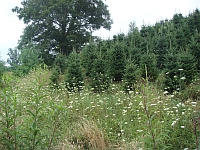 Biodiversity of flowering plants is key to attracting predators. Promote flowering weeds such as yarrow and clovers in ground covers around the trees. You may need to establish clover ground covers the year before setting trees. Allow field borders to grow up in grass and flowers. Even briars and brush help bring in natural predators. Bush hog these field borders every 2 to 3 years to keep vegetation in a state of early succession.
Biodiversity of flowering plants is key to attracting predators. Promote flowering weeds such as yarrow and clovers in ground covers around the trees. You may need to establish clover ground covers the year before setting trees. Allow field borders to grow up in grass and flowers. Even briars and brush help bring in natural predators. Bush hog these field borders every 2 to 3 years to keep vegetation in a state of early succession.
Culling Problem Trees
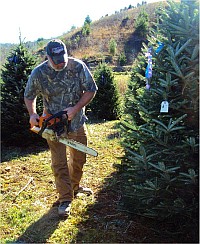 Fraser fir is a seed run crop. There is tremendous genetic diversity. Some trees are more prone genetically to pests such as SSM, BWA, elongate hemlock scale (EHS), and rosette bud mite (RBM). Cutting down and removing these trees will keep these pests from spreading to other trees.
Fraser fir is a seed run crop. There is tremendous genetic diversity. Some trees are more prone genetically to pests such as SSM, BWA, elongate hemlock scale (EHS), and rosette bud mite (RBM). Cutting down and removing these trees will keep these pests from spreading to other trees.
Shearing
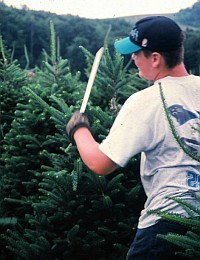 One method of pest control is to grow trees as quickly as possible. A good organic grower must be an expert shearer to make the best use of tree growth. Shear trees early to increase budset. Prune out cross-over branches that will become horns. Do not extend leader length to keep trees from becoming too thin and narrow. For more information on shearing see Shaping Fraser Fir Christmas Trees.
One method of pest control is to grow trees as quickly as possible. A good organic grower must be an expert shearer to make the best use of tree growth. Shear trees early to increase budset. Prune out cross-over branches that will become horns. Do not extend leader length to keep trees from becoming too thin and narrow. For more information on shearing see Shaping Fraser Fir Christmas Trees.
Organic Pesticides
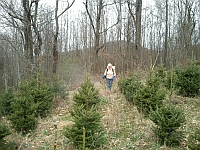 Organic pesticides do not give as good or as quick a kill as synthetic materials. Therefore it is important to scout to learn when pests first come into a field and treat them promptly when needed. Another issue with organic insecticides is the potential for soaps and oils to burn or discolor foliage. These materials, if misapplied, will cause yellowing and browning of the needles, which is often followed by needle shed. In most cases, the bud is not affected.
Organic pesticides do not give as good or as quick a kill as synthetic materials. Therefore it is important to scout to learn when pests first come into a field and treat them promptly when needed. Another issue with organic insecticides is the potential for soaps and oils to burn or discolor foliage. These materials, if misapplied, will cause yellowing and browning of the needles, which is often followed by needle shed. In most cases, the bud is not affected.
Sprayer Requirements
Most organic pesticides require complete coverage. A high pressure sprayer gives the most thorough coverage. You also need good agitation in the spray tank when horticultural oils are being applied so that the oil and water do not separate. For the smaller acerage grower who either cannot afford a high pressure sprayer or cannot find a reliable contract applicator, a backpack mistblower is a lower cost alternative.
Horticultural Oil — The Workhorse of Organic Pest Control
A good organic pesticide which will control or at least suppress almost all Fraser fir pests is horticultural oil. Oil controls pests by smothering them. Therefore, you have to get complete coverage of the tree so that pests on all surfaces are coated with the oil solution. For pest control, a 2% solution of oil (that is 2 gallons in 100 gallons) is required. At this concentration, however, the tree may be damaged. Needles may turn brown and drop off the tree.
Types of Oils to Use
To get the best pest control without foliage burn, use a highly refined horticultural oil. These are often called summer oils. Do not use a dormant oil as these will cause foliage burn. Look for oils with at least 92% unsulfonated residues on the label. It will list this value under the active ingredients.
Encapsulated Oil
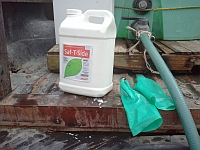 There are also an encapsulated oils on the market. The encapsulation process results in an oil that does mix with water. This is more expensive than regular oil, but you will not need good agitation in the spray tank.
There are also an encapsulated oils on the market. The encapsulation process results in an oil that does mix with water. This is more expensive than regular oil, but you will not need good agitation in the spray tank.
What Oils Will Control
A 2% solution of oil applied in mid-March will do a good job of controlling the following pests:
- BTA eggs
- SSM eggs
- Rust mites (HRM) and eggs
- BWA nymphs, crawlers and adults
Control of the following pests is not as good. A 2% solution of oil will only suppress the following:
- BWA eggs. However, there shouldn’t be any BWA eggs present in mid-March.
- BTA nymphs or adults. Therefore be sure to treat before the twig aphid eggs start to hatch.
- EHS
Timing of Oil Applications
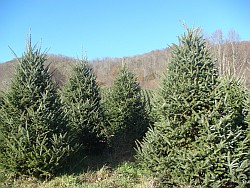
Winter (December through March)
The best time to treat for pests of Fraser fir using oil is in mid-March. Going ahead and applying oil preventatively each year regardless of what pests are present or how soon trees will be harvested is a good strategy. A second application may be necessary to control SSM or if Cinara aphids are a problem in the fall. A summer application of oil may be necessary to control EHS. Good control of EHS may take repeated applications of oil made two to three weeks apart.
Other Organic Pesticides
The following are other organic pesticides that have been successful at reducing pest numbers.
- Pyrethrims. These naturally occurring insecticides are extracted from flowers. Like synthetic pyrethroids, the man-made insecticides patterned for them, they are very broad spectrum and will kill natural insect predators.
- Insecticidal soap. This is particularly effective against Cinara aphids. There may be issues with yellowing foliage.
- Neem oil. This oil acts like an insect hormone mimic and interferes with the insect’s ability to feed and reproduce. Neem oil has been used successfully to control BTA.
- Cinnamite. This cinnamon extract has been used to control BTA successfully.
- Elemental sulfur. Sulfur has been successfully used to control HRM.
Special Considerations for Cinara Aphids
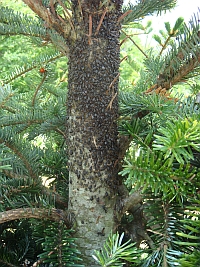 Most conventional Christmas tree growers treat all go-to-market trees with a bifenthrin product such as Sniper in the fall. A fall treatment for Cinara aphids can also be made in organic Christmas trees with either horticultural oil or insecticidal soap. However, it is expensive to treat all the harvested trees and most will not have aphids. Soaps and oils may cause discoloration of the foliage. If individual trees with Cinara aphids are identified at harvest, then those trees can be treated either with insecticidal soap or even washed out of the tree using water.
Most conventional Christmas tree growers treat all go-to-market trees with a bifenthrin product such as Sniper in the fall. A fall treatment for Cinara aphids can also be made in organic Christmas trees with either horticultural oil or insecticidal soap. However, it is expensive to treat all the harvested trees and most will not have aphids. Soaps and oils may cause discoloration of the foliage. If individual trees with Cinara aphids are identified at harvest, then those trees can be treated either with insecticidal soap or even washed out of the tree using water.
Special Considerations for Rosette Bud Mites
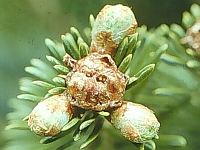 Rosette bud mites are the only pest that cannot be controlled with organic insecticides. Control of RBM in organic trees will have to rely on cultural practices such as selective harvesting and not interplanting. For more information on RBM control, see CTN-018a: Rosette Bud Mite on Fraser Fir.
Rosette bud mites are the only pest that cannot be controlled with organic insecticides. Control of RBM in organic trees will have to rely on cultural practices such as selective harvesting and not interplanting. For more information on RBM control, see CTN-018a: Rosette Bud Mite on Fraser Fir.


